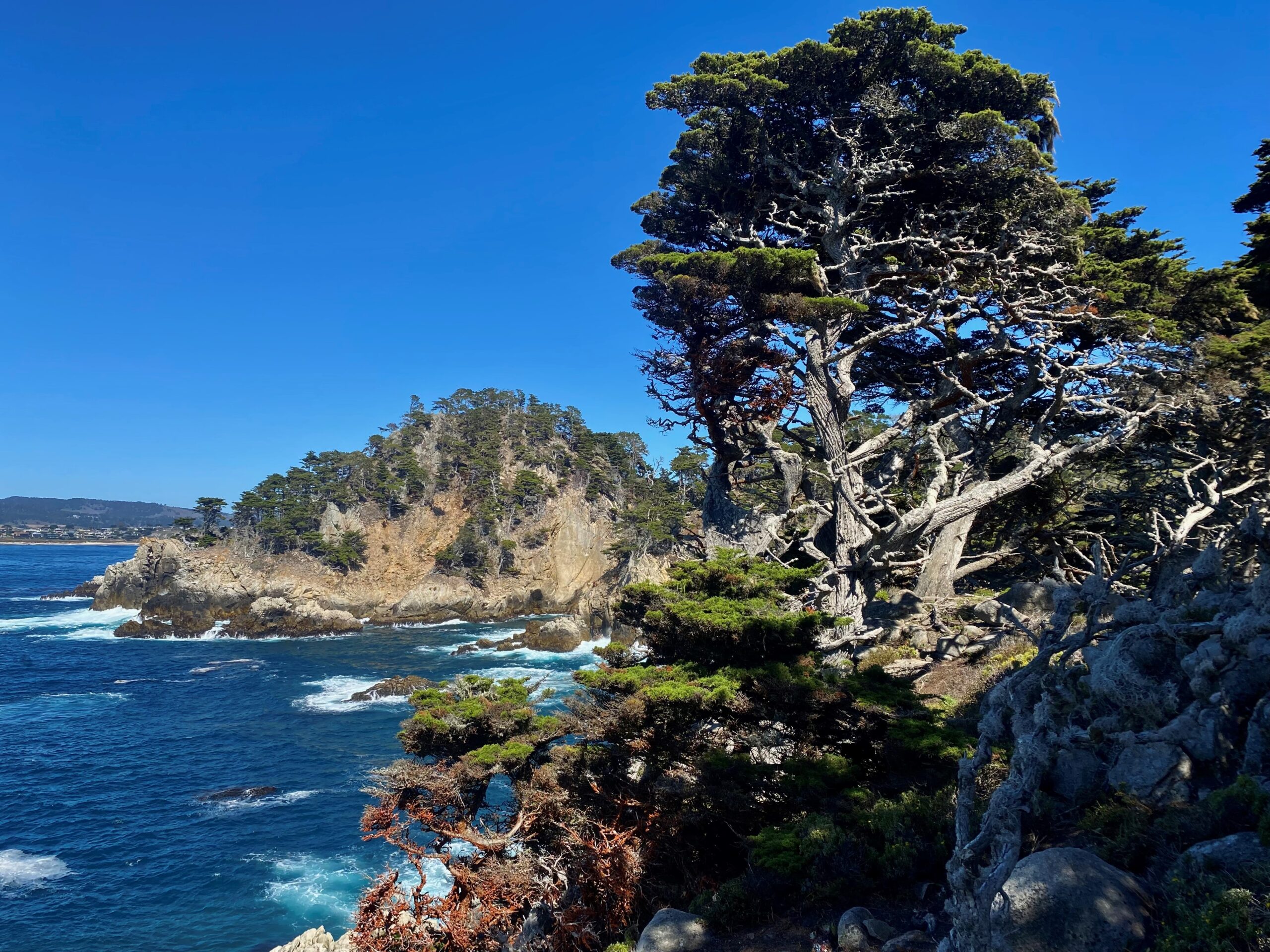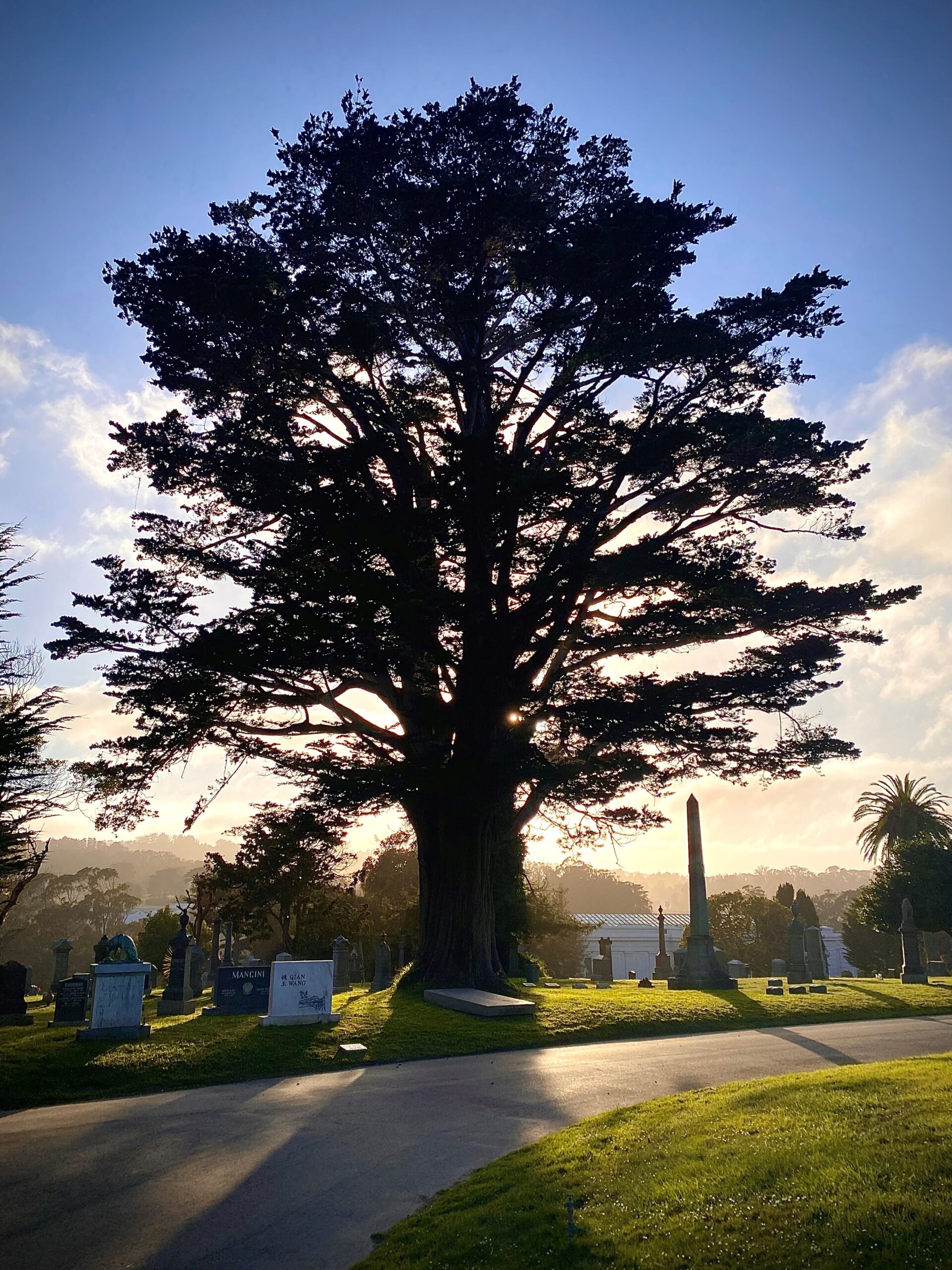
OLD HESPERO AND I
Love is where
A tree, a man
Find home in kinship
With each other
Love is where
We all must go
Walking our lives’ path
The human way
Love is where
Standing people
O, the wooden ones!
In silence, teach
Love is where
Old Hespero
My dear, kind friend lives
Within my soul…
If it’s possible for one finite human life to stand as a testament to the kinship, the ever-branching bond between the Sylvan and the Sapiens – perhaps that growing story is my own.
My love for trees traces back to the origin of my own consciousness, the very germination of my human experience. In my first waking memory upon this Earth, I was running in a circle with the blissful joy of childhood, round and round a ring of ivy surrounding three silver birches, branches weeping in the full foliage of summer.
I was just turning three years old, and visiting for the first time the house that would become my home for all of my youth, until I would branch out and leave the proverbial nest. So, from the beginning – from seed, you might say – it was the trees with me.
As an emerging adult, a much different place would grow as a home within my heart, as a sacred landscape formative in my journey to becoming a naturalist, arborist, and tree storyteller. This place is Bodega Head, of coastal California, and the cypress tree there – in truth, a grove of three – I fondly know as Old Hespero…

She lives set back amidst the grass of the headland, nestled a hundred paces away from the sandstone cliff edge and the crashing Pacific surf just beyond. I cannot recall my first instance of seeing her from afar, nor that inaugural moment of climbing up into her branches.
As the years and many shared moments have passed, my memories blend together, no longer discrete. But I will always remember – always know – the distinct feeling of being in her presence. I have witnessed thousands of hours in the company of this plant, a specimen for which centurial is an unjustly small word.
She is a primordial crone, a miraculously ancient being that has collapsed under her own gargantuan weight and yet then rooted to grow anew, layering into the earth and grafting onto herself too many times over the decades for us to guess where her original seed first germed.
She lives on as an ancient shelter, a fortress! The winds, they don’t enter, this place, where both prospect and refuge are found…
Through knowing Old Hespero, in cultivating my connection with this one specimen of Hesperocyparis macrocarpa, a kinship has blossomed from which I have found my purpose, my passion, the profound Why? of my life.
In witnessing this wooden one, each time I return on my humble pilgrimage up to Bodega Head, I invariably discover something new about trees. Her body language, her patterns of growth, the fibers and foliage that define her form I have long observed. In reflection, the gathering of these subliminal lessons is how I began to be an arborist. What sparked in awe of a majestic plant proceeded on to curiosity, then to a scientific thirst for knowledge, and eventually I came to believe in my profound love for trees and an intuitive awareness that it will be good to devote my professional life to their care. Without saying anything, Old Hespero showed me the way.
From this nascency, my exploration of the story of the Monterey cypress seeded, and still continues to evolve. Perhaps the truest beauty of working with trees, and all plants, for a living is the bountiful potential for life-long learning. Simply put, there is always room to grow! Upon my wandering journey to graduate school and beyond, my affinity for Old Hespero and her kin keeps branching out, to lands near and far, first along the central Californian coast to a rocky promontory known as Lobos.

My vision changes, year by year
Each time I visit thee
A conscious aging, sharéd journey
Of your growing majesty
I know you, closer, now than then
As branches broken, strewn
Across the frothy, windswept shore
My wonderment, begins anew
Wonderment – Composed in the company of the Veteran Cypress, 6.10.2022
Here upon the point, the ancestral population of Monterey cypresses still dances on the brink of the world. These trees are a surviving relict of a much broader coastal forest of Hesperocyparis macrocarpa in the geologic past. The old veterans of Point Lobos, together with the scattered groves of nearby Pebble Beach on the Monterey peninsula, comprise the smallest extant native range – less than two square miles! – of any indigenous North American conifer.
These venerable groves thrived as a cultural gathering site for coastal Ohlone peoples for thousands of years. They live on today as wooden inspirators for countless western artists, poets, and creative kin, guided by the muses of the forest to breathe their own beauty into this world.
I am a humble brethren of this intergenerational community, which includes a prolific poet by the name Clinton Scollard. In 1925, channeling his own experience of Lobosian wonderment, Scollard wrote the poem Lyrics of Lobos, excerpted below:
“Who has not trod on Lobos has not known
The face of Wonder intimately shown”[1]
[1] Streeter, Deborah, editor. Dancing on the Brink of the World: Selected Poems of Point Lobos. Point Lobos Natural History Association, 2003.
A deeply rooted majesty has grown on from this remote geographic origin, towards a global diaspora of profound and diverse cultural significance. This saga was seeded by a plant lover of the Victorian era. The German botanist Karl Theodor Hartweg, on a “plant hunting”

A deeply rooted majesty has grown on from this remote geographic origin, towards a global diaspora of profound and diversecultural significance. This saga was seeded by a plant lover of the Victorian era. The German botanist Karl Theodor Hartweg, on a “plant hunting” expedition commissioned in the early 1840s, toured the California coastline in search of seeds and plant material to bring back to London’s Royal Botanic Gardens of Kew.
Hartweg’s journey through the Golden State featured an exploration of the Monterey peninsula and its diverse flora. Notably, this included the formative collection of Cupressus macrocarpa, as the Monterey cypress was originally termed. Hartweg’s 1848 holotype defined the species to western science for the very first time; this ancestral cutting I have held in my own hands.
Quickly after the Hartwegian diaspora event, this species radiated through the Commonwealth, perpetuated by the dominant naval resources and global nursery trade prowess of the United Kingdom at the time. Hesperocyparis macrocarpa, as it is now termed, has come to be a prevalent plant in the cultures and communities of many places across the entire planet, a tale which I have been fortunate enough to retrace across three continents, and counting.
I owe a sincere thanks to the grace and generosity of Geraldine Knight Scott, a deceased professor of UC Berkeley’s College of Environmental Design. In passing, Scott left a portion of her estate as an endowment for future graduating students to travel the world exploring some particular aspect of environmental design. From Geraldine’s gift, I have witnessed the way of Hartweg and Hespero, quite literally following the Monterey cypress all around the world.
In late 2019, as a fellow of the Scott scholarship, I traveled to remote landscapes across the planet where this tree has taken root, both as a prodigiously gigantic plant and as an indelible part of the culture in places where she grows. Remarkably, despite such a small native extant population, this cypress species today has a cultivated ornamental distribution across a broader geography than any other indigenous Californian tree.
This presence is especially true in the landscapes of the Commonwealth, most notably New Zealand and Australia. The coastal farmstead plantings and memorial Avenues of Honour present in these two island nations, respectively, define a growing legacy of cypresses nearing two centuries of Australasian cultivation. This story is part of a profound diaspora, a tale of trees and people, growing on more than six thousand miles from the seeded origin of Lobos.

“I sit before the grandest pair of Monterey cypresses that my eyes have ever known, each approaching ten feet in diameter and embracing one another limb for limb, entwined and rising from the earth like behemoths from another realm. I almost don’t believe how impressive their presence is, the growth far surpassing the vigor of even the ancient ones I have seen at Point Lobos. It is stunning, and I am coming to understand that the might of these trees is nearly commonplace, ubiquitous, in coastal, rural New Zealand.”
Travel log excerpt, composed at Brook Homestead campground,
Awhitu regional park, New Zealand 9.12.2019

Ellerslie Avenue of Honour – World War I memorial trees photographed during centennial year of planting, one tree for each fallen soldier
Victoria, Australia 10.12.2019
This winding, weaving global love affair eventually brought me, and Old Hespero too, to yet another sacred landscape that is now my professional home – Cypress Lawn Arboretum. A historic cemetery founded in 1892, of which this one species is the California native namesake, Cypress Lawn has been a meaningful place of trees since its origin in the late 19th century. Our founder, Hamden Holmes Noble, was the progenitor of a living collection of trees of immense heritage, today including over 150 discrete woody taxa and plants from every habitable continent well over a century in age.
None of these is more defining than the Monterey cypress, the plant that names the place. Now, in the lee of several original plantings of the Arboretum’s cypresses, live the children of Old Hespero herself.
Cultivated from seed, the direct offspring of the tree that started it all for me, today number the living of our beloved memorial park. With stewardship in the seasons ahead, these wooden ones will grow the Noble story of trees and people in kinship together, celebrating life!

Specimen cypress in Section C of the Arboretum’s foundational East Campus, fondly known as Max, named after my beloved dog, d. 10.24.20
In truth, my love story with Old Hespero is but a humble anecdote, sharing just a glimpse of the profound relationship between all trees and all people. It may not be as explicit as my own tale, but I steadfastly believe in the potential for every human being to embrace a transformatively good connection with plants. Garden-folk know this feeling well, and I would wholeheartedly encourage each “plant person” reading this to contemplate – and then compose! – your own love story.
As stewards and participatory ecologists of the landscapes we tend, the onus lies on us to pass along this message of kinship to our friends, our neighbors, our world. As with the Monterey cypress, this is an intergenerational story, seeded in the primordial past, rooted in the present, and growing into the uncertain future we all must inhabit, trees and people alike.
That original alliance, from our primary dwellings as primates on through to the forests of our future, may indeed be the key of reciprocity to our very survival. In this tale, there is hope, there is resilience, and there is joy. This is my love story; do you have one to share?